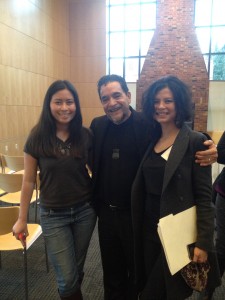The Hispanic International Studies major, also known as ‘HISP’ is not a very common major at UPS. I personally know only 3 other people in the major! Despite that I think that HISP’s interdisciplinary nature is especially applicable to doing good socially-inspired work within the borders of the United States and transnationally into Latin america , Spain, and even little known Hispanic countries such as the Philippines.
The major consists of 8 units of Spanish language, literature, and culture; 3 units of Politics & Government; and 3 units of Economics and/or business. These are some of my favorite classes I’ve taken in the major.
- Utopian Spaces in Latin American Literature
- Central American Literatures: On Margins, Banana Books, Wars, Diaspora, and Disenchantment
- The City and the Novel in Latin American Literature
- The History of Colonial America
- The Economics of Underdevelopment
- International Organizations
- Human Rights and Law
- International Marketing
- Populism in Latin America
- Tourism and the Global Order
- The Business of NGO
- Intro to Comparative Politics
- Oral Communication Abilities
- Pre-Colombian Art
At Puget Sound, one of my favorite classes has been Central American Literatures taught by Professor Oriel Siu. We explored literature that interrogates the workings of power and oppression, from the Popol Vuh, to indigenous Maya denunciations of military dictatorships, and the “modernization” brought about by the Bananeras in Central America as a marginalizing project. This course was also a safe space for me to explore my identity as a student of color at Puget Sound, and as a mestiza Filipino-American coming from a country that has also suffered a history of imperialism by Spain and the United States.
One of the classes I enjoyed most when I was studying abroad at the Universidad Católica de Chile was Pre-Colombian Art. In this class we explored the following themes: the “othering” of American art and Shamanism, the myth and ritual in the art of Andean cultures such as the Selk’nam and Tiwanaku among many others, the art of the Maya and Aztec of Mesoamerica, and finally, the manifestations of these art forms in contemporary Western art and syncretism. From this I took away an appreciation of diverse artistic forms from pre-Hispanic America and learned to understand them in their historical and cultural context.
Through the major I have been able to study the history of Latin America and Spain, from Pre-Colombian America, to studies of Modern America: from the construction of the metropolis and its representation in the Latin American novel, the social processes of modernization from Eduardo Galeano’s Las venas abiertas de América Latina, to the politics of populism under Perón, Fujimori, and Velasco Ibarra to Chávez. I have supplemented these studies with my emphasis in Global Development studies, where I have incorporated my interest in Latin American studies into discussions, and for my IPE class ‘The Business of Alleviating Poverty’ wrote a paper entitled “The Role of Civil Society in the Protection of Mapuche Indigenous Rights in Chile’s Transition to Democracy.”
Some of the most interesting paper titles I’ve written this year:
- Can FIFA’s Corporate Social Responsibility Put an End to Racism?
- The Role of Civil Society in the Protection of Mapuche Indigenous Rights in the Transition to Democracy
- Rigoberta Menchú: her living testimony and the Mayan Renaissance
- The Psychomagical Family Tree: a Comparative essay
 of Gabriel García Márquez’s One Hundred Years of Solitude and Alejandro Jodorowsky’s film “La danza de la realidad”
of Gabriel García Márquez’s One Hundred Years of Solitude and Alejandro Jodorowsky’s film “La danza de la realidad” - Is it Really “More Fun in the Philippines”? Reconstructing Place Brand

